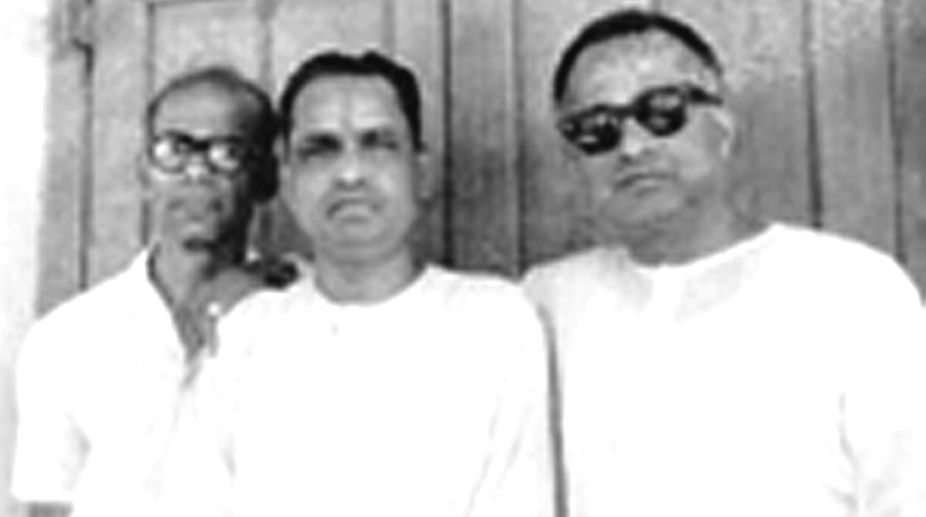Old-timers in Indore remember how the cultural life of their city and in fact a much larger surrounding region was enriched for decades by the threesome of Kumar Gandharva, the famous musician, Rahul Barpute, the great editor and orator and last but not the least, their very own artist Vishnu Chinchalkar who remained accessible to people till his last days. These three were very friendly to each other. Kumar Gandharva once said that he could see the beauty of nature more clearly through the eyes of his friend Vishnu while Chinchalkar said that he could better understand the sounds of the world through the music of his friend Kumar.
While all three were great in their own way no one reached out to people like Vishnu. Even at the peak of his fame he would struggle to catch a bus to reach a remote village where a meeting had been arranged on the role of artists and writers. He remained active in social organisations involved in issues of the underprivileged for a long time and got involved in issues of great social relevance. In the middle of all this he took a special happiness in reaching out to children. No matter how many awards and honours he got, his simple habits of inter-mingling closely with his people and remaining involved in their problems and struggles never changed.
While Vishnu was studying at the Indore School of Arts, his teachers liked his landscapes and portraits so much that they did not interfere and gave him the freedom to go his own way. This helped him later to be bold enough to embark on some very novel experiments. His senior M.F.Husain commented very appreciatively on the boldness of his lines. He achieved fame at a very young age. His landscapes of Kumaon were widely praised. He was a guest of honour for some time at the Calcutta Fine Arts Society. Then moving on to Mumbai, he started drawing for the Illustrated Weekly of India.
Advertisement
But even while he had begun to make waves in the big city’s art circles at a young age, something within him kept prompting Vishnu to return to his roots. Vishnu thus returned to Indore to be close to his home town and its nearby villages. Here a long-term relationship started with concerns of the working class and weaker sections through the Jagran organization. Secondly, another long-enduring relationship started with Nai Dunia newspaper which was edited by his friend Rahul Barpute for a long time.
Chinmay Mishra, an Indore based writer says, “Guru Ji (this is how people in Indore call Vishnu Chinchalkar) provides a rare example of an artist who had achieved international fame at a young age and yet chose not only to return to his roots but also involved himself closely in concerns of local people while continuing his highly creative work as an artist.”
Kumar Siddharth, who is involved with several social initiatives in Indore says, “Guru ji felt very happy when he was with children and children were fascinated by his easy-going skills in turning paper into sparrows and monkeys and what not. He had a lifelong interest in using artistic skills to improve educational materials including books for small children.
At an early stage, Nai Duniya had attracted attention as a Hindi newspaper coming from a relatively smaller city which could compare favorably in content and layout with the more resourceful newspapers of Delhi. The artistic skills of Chinchalkar contributed considerably to this reputation.
Vishnu was happy at the way in which his close friendship with Rahul and Kumar, his involvement in the struggles of people, his contribution to a newspaper which raised such issues and his art work had become integrated after his return to Indore. It was perhaps this closeness to people and the confidence that came from this which emboldened him to experiment with his art.
Vishnu was inspired by a simple incident in the life of Gandhiji. It was raining mildly when Gandhiji’s hosts in Mysore said that they were arranging for him to visit a beautiful waterfall. Gandhiji said pointing to the beautiful rain that this too was a very nice waterfall and that he did not need to visit a waterfall miles away.
The sensitive artist within Vishnu took an important message from this seemingly innocuous statement, that we do not have to go long distances in search of the beauty of nature and the world but should open our eyes to the beauty and intricacies that exist all around us. Vishnu then started using small branches, twigs and leaves from nearby trees, (not any special decorative species but any ordinary tree) for carving out various artistic images. Next he even took up discarded products of everyday use to turn them into artistic images.
Initially there were some efforts to ridicule this but later even the exhibitions he held in big cities were highly appreciated. Oblivious to both praise and ridicule, Vishnu continued to experiment with his new ideas along with his more traditional art work and his work at Nai Duniya. Even when his health started deteriorating and he needed rest, he was content to spend long hours resting in his small garden, no doubt also seeing art in the nature around him.
Born in 1917, Vishnu Chinchalkar lived a life where he was at peace with himself and the world around him. He died on 30 July 2002, leaving behind a legacy of rich, diverse and experimental work.
(The writers are freelance journalists with a close involvement with several social initiatives and movements)
Advertisement











